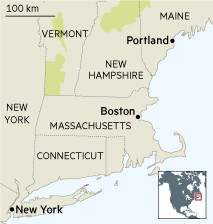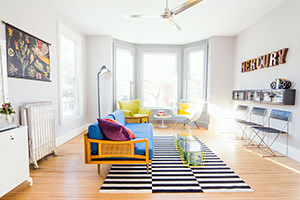The other Portland steps into the spotlight

Simply sign up to the Life & Arts myFT Digest -- delivered directly to your inbox.
I rolled into town on the Amtrak “Downeaster” on a September day when the late summer heat made it easy to forget that Portland endures winters as bitter as those in Chicago or Detroit. The taxi took me along a waterfront where lumber yards and fish docks surrounded the occasional shiny new chain hotel. Further uptown, tenements and office buildings in brick and granite gave way to tree-lined streets of solid-looking Victorian mansions.
If your idea of New England is based on a vague composite image of autumn leaves and pretty little clapboard houses, Portland will challenge your preconceptions nicely. Rough-hewn as well as civilised, this is a hard-work town with a greater dynamism, and a much bigger heart, than its population of 66,000 might suggest.
The taxi left me at the Mercury Inn on State Street, one of a handful of B&Bs in big 19th-century houses (two others are the Danforth and Pomegranate inns) originally built for the local bourgeoisie. The Mercury’s owners, longtime Maine resident Tim Karu and his husband Jacob Krueger, opened their “modern sustainable lodging” this year, applying a layer of bohemian chic (think Charles Eames chairs, industrial lighting, organic breakfasts) to the bourgeois architecture of Portland’s Parkside area with the aim of “making it somewhere we’d like to stay ourselves”.

Karu grew up in Kennebunk, summer retreat of the Bush family, and remembers childhood trips to Portland at a time when Downtown and the Old Port were not areas you would want to linger. There were time-honoured sights, such as the Portland Museum of Art – then, as now, the city’s leading public gallery (worth visiting just for its muscular seascapes by Winslow Homer, doyen of Maine painters) – but there wasn’t a whole lot else to do. Moreover, said Karu ruefully, there was nothing decent to eat, unless you were ready to “rip through a lobster” in one of the canteen-like establishments on the harbourside.
Two decades later, Portland’s rebirth is plain to see. A stroll down Congress Street on a sunny morning, on brick-paved sidewalks that age had pushed up into strange undulations, took me past the Maine Historical Society (with its sleek 2009 extension), the Maine College of Art – fuelling the creative life of Downtown from its new headquarters in a former department store – and a slew of new fair-trade coffee shops, craft beer bars, galleries, live music venues and vintage fashion emporia. Banners marked out the newly-designated “Arts District” between Congress Street and Commercial Street. There was a grittiness about Portland’s cityscape, its black fire escapes snaking up smoke-stained walls, that contrasted with the small-town cheeriness of its people. There was little traffic and cars stopped to let you cross the street.

The risk of converting industrial hell into consumer paradise is that the result can look twee and fake or, almost as bad, that it becomes an alternative universe entirely inhabited by thin young men with beards toting rye bread and Apple Macs. Happily, Portland is neither of those things. In the East Bayside area, with its abandoned factories where gaunt faces peered from dark corners, I managed to find some old-fashioned urban grime. But even in these wastelands there were green shoots: after a tasting at Rising Tide, most successful of Portland’s estimated 30 local breweries, I headed for dinner among the food trucks at Flea For All – three floors of vintage heaven that are pointing the way for new businesses in the East Bayside area.
Portland’s story is one of decline, fall and reinvention – several times over. Not for nothing is the city’s emblem the phoenix and its motto resurgam (“I will rise again”). In one of its upswings, it grew rich as an ice-free harbour frequented by Canadian trading ships. Largely destroyed by a fire on Independence day 1866, it was quickly rebuilt. But in the 1970s, a giant out-of-town mall sucked the commercial life out of Downtown. Grand Trunk railway station was demolished and Congress Street, a once-proud retail thoroughfare whose Maine Bank and Trust Tower of 1909 was the tallest building in New England, fell into Detroit-style dereliction: by the 1990s, trough of the city’s decline, no fewer than three department stores had closed their doors.

On Munjoy Hill, currently the most desirable of the city’s residential neighbourhoods, a cool wind pushed up from the harbour. The streets hereabout were an architectural sampler of historic housing in gothic, Queen Anne, and colonial revival styles. To left and right off Congress Street, airy avenues swooped down towards a steel blue sea studded with forested islands.
A few blocks up from the waterfront, solid brick-built warehouses bore names such as Molasses and Cinnamon. At her workshop on Danforth Street, Dory-Anna Richards Waxman was busy weaving the woollen shawls she sells at the Old Port Wool and Textile Company. “Thirty-five years ago there was not a lot going on around here,” she recalled. “The Old Port was pretty quiet. Most of the woollen mills had closed. There used to be 43 piers, now there are 17. Then a whole lot of old hippies started moving in and opening their craft shops and galleries. That’s when the changes kicked in.” She smiled a knowing smile.

Portland’s current renaissance has been inspired, in part, by the theory that fomenting creative activity can provide the basis for economic regeneration. At a harbourside café, typically Portland in its cavernous bare-brick interior, I met up with Jennifer Hutchins, executive director of a City Hall-sponsored body set up in 2008 with a mission to nurture the “creative economy”. Over a first-rate cappuccino (Portland, like its West Coast namesake, is crazy for coffee), Hutchins explained how Downtown was turned around not by means of massive investment but with modest proposals such as the First Friday Art Walk, held once a month, when artists and craftspeople set up stalls in the street and residents and visitors turn out to stroll, shop and socialise.
The Art Walk, founded 14 years ago as an adjunct to the art gallery scene, has become a hugely popular community event whose economic value to the city Hutchins estimates at a million dollars a year. Meanwhile, the city’s rising creative and gastronomic profile – combined with some of the most affordable real estate in the northeast – is bringing in people from bigger US cities. “We want to show that Maine isn’t just lobstermen and lighthouses, but a great place to live and set up businesses,” said Hutchins, going on to introduce me to a furniture designer sitting at the next table who had just moved here from Brooklyn.

In the Facebook age it is puzzling that this town has stayed under the radar for quite so long. The global fame of Portland, Oregon, spiritual home of hipsterdom and a city so cool it has its own TV show (Portlandia), may have confused the punters for a while. But news of “the other Portland” is getting out at last.
On Congress Street, the Art Walk was in full swing. Outside the Bank of Maine, a group of female belly dancers was going through its moves to a country and western soundtrack of yee-haw fiddles and harmonicas, while the Maine Marimba Ensemble whipped up a storm on a nearby street. There was eccentricity and quaintness in spades. A man with a typewriter, squatting on the ground, advertised himself as a poet for hire. I was left with an impression of Portland as diverse in age, race and condition, and with a notable reluctance to take itself too seriously.
Culture is one thing but if there’s one area where the new Portland has truly excelled, it is food and drink. In the past two decades the city’s restaurant sector has mushroomed and, as in the rest of the country, good ingredients are increasingly high on the agenda. The Saturday morning farmers market under the trees of Deering Oaks Park was a superb example of this sometimes disappointing genre, and reminded me of three things: the current American passion for locally grown and organic produce, the importance of agriculture in the state of Maine, and the universal (and surely unconscionable) popularity of kale.

For the moment, informality and heartiness rule in the city’s kitchens. Among the best things I ate here were the barbecue pork ribs and brisket at Salvage, the Chinese lobster dumplings at Empire, the poutine with fried egg at Duckfat, and the fresh sweetcorn fritters at Central Provisions.
But a serious star has emerged in the shape of Vinland, since last January the city’s leading contemporary restaurant, where chef David Levi favours localism, seasonality and foraging. This is the place Portland needed to crystallise its gastronomic ambitions once and for all. Its gold painted stucco ceiling and bentwood Scandi-style chairs create one of the classiest restaurant interiors in the state. This was also where I realised an Allagash Tripel ale, nutty, fruity and Portland-brewed, could marry as elegantly as any fine wine with an organic cheese from Aroostook County, way up in the woods of northern Maine. “Ripping into a lobster” doesn’t come close.
Correction: This piece was amended on October 27, removing the incorrect statement that Portland endures “one of the longest, coldest winters of any American city”.
——————————————-
Details
Where to stay
The Danforth Inn, 163 Danforth Street, doubles from $189, danforthinn.com
Mercury Inn, 273 State St, doubles from $110, mercuryinn.com
Pomegranate Inn, 49 Neal St, doubles from $149, pomegranateinn.com
Where to eat
Vinland, 593 Congress St, vinland.me
Duckfat, 43 Middle St, duckfat.com
Eventide Oyster Company, 86 Middle St, eventideoysterco.com
Empire Chinese Kitchen, 575 Congress St, portlandempire.com
Central Provisions, 414 Fore St, centralprovisions.com
Blue Rooster, 5 Dana St, blueroosterfoodco.com
Photographs: Chris Bennett; Greta Rybus
Comments